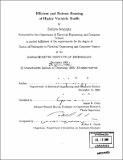Efficient and robust routing of highly variable traffic
Author(s)
Sengupta, Sudipta, 1974-
DownloadFull printable version (21.47Mb)
Other Contributors
Massachusetts Institute of Technology. Dept. of Electrical Engineering and Computer Science.
Advisor
James B. Orlin.
Terms of use
Metadata
Show full item recordAbstract
Many emerging applications for the Internet are characterized by highly variable traffic behavior over time that is difficult to predict. Classical approaches to network design rely on a model in which a single traffic matrix is estimated. When actual traffic does not conform to such assumptions, desired bandwidth guarantees cannot be provided to the carried traffic. Currently, Internet Service Providers (ISPs) use gross capacity over-provisioning and manual routing adaptation to avoid network congestion caused by unpredictable traffic. These lead to increased network equipment and operational costs. Development of routing infrastructures that optimize network resources while accommodating extreme traffic unpredictability in a robust and efficient manner will be one of the defining themes in the next phase of expansion of the Internet. This thesis proposes two-phase routing as a capacity efficient and robust strategy for handling highly variable traffic. The scheme allows preconfiguration of the network such that all traffic patterns permissible within the network's natural ingress-egress capacity constraints can be routed with bandwidth guarantees without requiring detection of traffic changes in real-time or reconfiguring the network in response to it. (cont.) The scheme routes traffic in two phases -- traffic entering the network is sent from the source to a set of intermediate nodes in predetermined split ratios that depend on the intermediate nodes, and then from the intermediate nodes to the final destination. The scheme has the desirable properties of supporting static optical layer provisioning in IP-over-Optical networks and indirection in specialized service overlay models unlike previous approaches -- like direct source-destination path routing - for handling variable traffic. This thesis represents the first comprehensive study, problem formulation, and algorithm design for many aspects of two-phase routing. Our contributions can be grouped into three broad parts. First, we consider the problems of minimum cost network design and maximum throughput network routing for the scheme. We give a simple solution for minimum cost network design. For maximum throughput network routing. we design linear program.ling based and combinatorial algorithms. We show how the algorithms can handle a total cost constraint for maximum throughput two-phase routing. This can be used to solve the link capacitate version of minimum cost two-phase routing. (cont.) We establish theoretical bounds on the resource requirements of two-phase routing under throughput and cost models with respect to the optimal scheme that is allowed to make the routing dynamically dependent on the current traffic matrix. We also generalize the traffic split ratios to depend not only on the intermediate nodes but also on source and destination of traffic and solve the corresponding optimization problems. Second, we consider making two-phase routing resilient to network failures. Two-phase routing in IP-over-Optical networks can be protected against router node failures through redistribution of traffic split ratio for the failed router node to other intermediate nodes. We propose two different schemes for provisioning the optical layer to handle router node failures. We develop linear programming formulations for both schemes and a fast combinatorial algorithm for the second scheme so as to maximize network throughput. Two-phase routing can be made resilient against link failures by protecting the first and second phase paths using pre-provisioned restoration mechanisms. We consider three such restoration mechanisms - local (link/span) restoration, K-route path restoration, and shared backup path restoration. (cont.) We provide linear programming formulations and combinatorial algorithms for maximum throughput two-phase routing with local restoration and K-route path restoration. We show that the problem of maximum throughput two-phase routing with shared backup path restoration is JVP-hard. Assuming an approximation oracle for a certain disjoint paths problem (which we also show to be AP-hard), we design a combinatorial algorithm with provable guarantees. Third, we consider the application of two-phase routing to multi-hop Wireless Mesh Networks (WMNs). These networks have recently been of much research interest due to their lowered need for wired infrastructure support and due to envisaged new applications like community wireless networks. We extend our optimization framework for maximum throughput two-phase routing in wired networks to handle routing and scheduling constraints that are peculiar to WMNs and arise from the requirement to handle radio transmit/receive diversity and the phenomenon of wireless link interference. We evaluate various aspects of two-phase routing on actual ISP topologies using the developed algorithms. For the WMN application, we use randomly generated WMN topologies for the evaluations.
Description
Thesis (Ph. D.)--Massachusetts Institute of Technology, Dept. of Electrical Engineering and Computer Science, February 2006. Includes bibliographical references (p. 316-324).
Date issued
2006Department
Massachusetts Institute of Technology. Department of Electrical Engineering and Computer SciencePublisher
Massachusetts Institute of Technology
Keywords
Electrical Engineering and Computer Science.